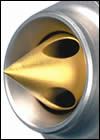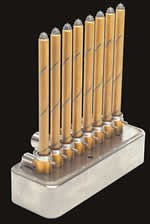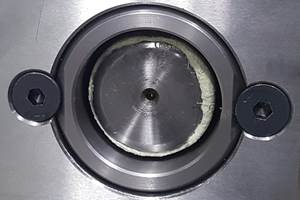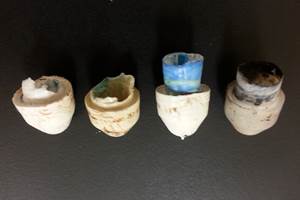NPE 2003 News Wrap-Up: Hot Runners
From complete hot halves to individual nozzles, a host of new products promise smaller gate vestiges, less maintenance, better temperature control, and lower cost.
At the big show in Chicago last June, at least 20 hot-runner suppliers overhauled their product lines and came out with dozens of new products. As always, key themes were easier installation, longer life, lower wear, and better temperature control. Specialized designs for very small parts, complex shapes, PET preforms, and large automotive parts also made their debut. Among the novelties were a simpler design for a bolt-on hot half, angled drops with a variable-angle hinge, and the first hot-runner systems to incorporate the MeltFlipper runner-balancing technology in the manifold. (New hot-runner temperature controls will be covered in November.)
Drop-in systems flourish
Conventional “bolt-on” hot-half systems require the assembly to be mounted between retainer plates, but that’s not the case with a new alternative announced at the show. Incoe rolled out its “unitized” hot-runner system that is fully assembled, prewired, and bench tested like a conventional hot half, but it eliminates the retainer plates. The lower-cost system employs a threaded instead of flanged nozzle, allowing the system to be connected directly to the manifold. This approach reportedly eliminates leakage and enhances uniform heat transfer from the manifold to the nozzle.
The unitized concept can be taken a step further in what Incoe calls an “integrated” system. A simple add-on feature to the mold allows the unitized hot runner to be completely exposed to permit replacement of nozzle heaters and thermocouples while the mold is in the press.
Mold-Masters rolled out its new Flex-Series of custom systems for large automotive parts or sequential valve gating. Runner diameters are from 6 to 18 mm and nozzle lengths run up to 900 mm. It can handle shot sizes up to 3500 g per nozzle. It comes fully assembled with more durable wiring channels for easy installation and maintenance. This “plug-and-play” system is offered in five levels (Basic, Advanced, Complete, Evolution, and Master), differentiated by additional features for mounting, control, and operation. New features include an integral heating element that is profiled along the entire length of the nozzle body, and new heater plates that optimize heat distribution. The screw-in 230V nozzles have a new nozzle guide and improved sealing.
Two firms are now offering complete custom hot halves for the first time—Heatlock of Sweden (represented here by DMS) and Hasco America. Hasco also now offers custom manifolds in addition to its standard line.
More new systems
Incoe’s new Opti-Flo is the first hot-runner system to integrate the MeltFlipper system from Beaumont Runner Technologies. Built into the manifold, the MeltFlipper manipulates the melt to correct shear-induced flow imbalances that lead to inconsistent cavity filling in geometrically “balanced” molds. The MeltFlipper eliminates the need to use static mixers that restrict flow or the use of a different temperature in each drop to balance flow.
Mold-Masters has replaced its Dura Series with a new core product line called the Master-Series. This modular line complements the custom Flex-Series for large parts. Mold-Masters says the Master-Series incorporates dozens of improvements aimed at more uniform heat profiles, easier color changes, wider processing windows, and greater uptime. The series uses new Endura high-heat tips with a corrosion-resistant coating. The new Tri-flow tip reportedly gives better flow that can reduce part stresses and ease color change.
Also, a new thermally conductive coating, called CIC (Conductive Infusion Coating) works in conjunction with an improved heating profile to enhance thermal uniformity. A new embedded heater that extends from flange to tip improves control, and the new heater profile is said to use 50% less wattage than competitive systems. A new bimetallic gate also provides better heat conductivity. All told, the Master-Series reportedly can permit lower melt temperatures without premature freeze-off, thereby enabling shorter cycle time and reduced gate vestige.
The Master-Series also has Visco Seal, a proprietary design that utilizes a thin film of melt that freezes off between the nozzle and mold to prevent leaks. Another new sealing technology, called Master-Seal, is used between the manifold and nozzle.
Meanwhile, Synventive Molding Solutions has reintroduced the Kona name in its brand-new Kona XP hot-runner line intended for a broad range of applications from small cosmetic parts to large automotive components. The system merges the firm’s heat-pipe nozzles with its MultiZone (MZ) manifolds to combine the design simplicity and superior temperature uniformity provided by heat pipes with the lower cost of the MZ design. The system incorporates a complete line of nozzles with replaceable tips and a range of gating choices. Systems can be constructed as a manifold, a partially assembled manifold with a wire guard, or a fully assembled hot half. Synventive now also offers its Dynamic Feed valve-gate system with either its MZ or heat-pipe manifolds.
The new Rheo-Pro hot-runner system was developed through a partnership between MHT Mold Hotrunner Technology of Germany and MHS Mold Hotrunner Solutions in Canada. Rheo-Pro can be supplied as components, prewired systems, or turnkey hot halves. It is designed for custom large-part applications and features large gates to minimize shear loads and short flow paths to minimize melt volume in the runner and dwell time. Large optical components with difficult gate-placement requirements can be addressed with a special angled manifold.
Husky’s Pronto line of quick-delivery, configurable hot-runner systems has gained three new manifold configurations for asymmetrical layouts. The 2T system is for two off-center drops in a T-shaped manifold. The 4N is for four independent drops in a trapezoidal arrangement. And the 8H is an eight-drop design said to increase pitch flexibility. Husky’s Ultra 1000 nozzle was also added to the Pronto line to accommodate larger parts.
Small is big
Continuing the trend to ever-smaller hot-runner solutions, Mold-Masters brought out its smallest nozzles yet. Femto-Lite nozzles permit a gate pitch of 17 mm for inside gating in hard-to-reach areas of medical or cosmetic parts. With a nozzle body diameter of only 10 mm, they have a relatively generous flow channel of 3.5 mm for shots of up to 5 g per nozzle. These are part of the new Master-Series with all the features of that line. Unlike some other mini nozzles, these have individual thermocouple control, a choice of hot-tip or sprue gating, and the same 220/230V power as larger components.
D-M-E’s Stellar line for micromolding, with tip spacing as small as 17 mm, is now offered in a new quick-delivery program. Users can select standard or custom nozzle-plate thicknesses. Systems with up to 16 drops ship in three to five working days. “Package systems” with standard or custom nozzle thicknesses ship in five to 10 working days.
Going slightly larger, Ewikon’s new Slimline HPS III-S nozzle has a minimum gate pitch of 28 mm. Flow-channel diam. is 4.5 mm and nozzle length is 69 to 179 mm. The low-volume melt seal near the gate is said to facilitate color changes.
Heatlock (represented by DMS) came out with the Platform-30 hot-tip nozzle for tighter-pitch applications. The ceramic-insulated nozzles range up to 30 mm diam. with flow channels up to 6 mm and shot weights to 350 g.
For complex parts
Mold-Masters unveiled two new technologies for stack molding and hard-to-gate applications. Its new Stack-Link is a melt-transfer solution for stack molds that reportedly eliminates drooling and stringing while providing a completely self-sealing shut-off that has minimum pressure drop.
In addition, its new Pivot-Link design for valve gating on curved or angled surfaces such as automotive lenses is the first such system to permit changes in angle. The pivoting nozzle can be rotated in three axes over a maximum range of –30° to +90°. It has adjustable pin height and an integral hydraulic unit.
A line of angled drops is new from Plastic Engineering & Technical Services(P.E.T.S.) The design reportedly reduces shear and cavity pressure, which may allow use of a smaller mold and press. It also may be possible to use low-vestige tips, which is not usually an option, the company says.
Lots of new components
Gate-Mate Lite is a new line of hot-runner nozzles from D-M-E with a bodiless design that reportedly leaves no witness marks on the part. A conductive beryllium-copper tip delivers precise heat for exact gate control and minimum vestige. The series is suited for direct gating and multi-cavity, thin-wall applications. Starting next month, it will be offered in 10 nozzle lengths from 42 to 130 mm. The nozzles can handle up to 225-g shots of commodity or engineering materials.
Zero-vestige parts of commodity or engineering materials are also said to be molded with the new Precision series valve-gate nozzles from Fast Heat. The valve pin is designed to require a reduced shut-off force and thereby achieve a secure seal for better part quality. Superior pin alignment is said to minimize wear of the gate diameter. Meanwhile, a patented sleeve heater reportedly delivers superior heat transfer and extends heater life. The pin, tip, thermocouple, and heater are replaceable while in the press. The valve gate is offered in flow diameters from 0.25 to 0.625 in., nozzle lengths of 3 to 12 in., and shot weights from 5 to 3000 g.
Faster cycles and reduced downtime are benefits claimed for the Solution “thermal-spike valve torpedoes” from Duratherm Processing Systems. The patent-pending “thermal valve gate” is similar to the Seiki Spear system. It has a thermocouple-controlled body heater and an independent heater embedded in ceramic for the spike tip. The “valve” action is achieved with on/off tip control in a timed sequence synchronized with the clamp action. The probe has a removable tip, thermocouple, and power leads.
Meanwhile, Seiki Valve & Spear System rolled out its new ESP hot-runner series for engineering resins. The series can operate at temperatures up to 750 F and is offered in several diameters starting around 18 mm. Lengths range from 62 to 92 mm and shot weights run 50 to 100 g.
Packaging and medical applications are targets for a new line of externally heated, multi-tip nozzles for direct horizontal gating from Ewikon Hotrunner Systems. The HPS III MH1 and MH2 series are offered in standard lengths of 50, 90, and 130 mm. Both series have exchangeable thermocouples and heating elements, and the MH2 has exchangeable tip inserts, too.
The MH1 design gates up to four parts. Standard pitch diam. is 22 mm and shot weights run 8 to 30 g. They are best for PE, PP, ABS, PS, and PMMA. The MH2 nozzles have two or four gates with tips that are fixed in a split mold insert that allows the nozzle shaft to slide vertically to compensate for thermal expansion of the shaft. Keeping the tip centered avoids cold slugs in the gate. These come in additional lengths of 30 70, or 110 mm for front installation and can process PE, PP, and TPE.
Ewikon also released new HPS III-MV series multi-tip nozzles for direct vertical gating. MV nozzles, intended for use with a manifold, can gate up to eight parts. The MVE hot-sprue version has up to four tips.
Ewikon also showed two new 230V externally heated nozzles for single-gate applications with commodity resins used in fast-cycling molds. HPS III-K nozzles have a special sealing approach in the shaft that’s said to simplify mold construction. They have a 3.5-mm diam. flow channel and come in standard lengths of 39 to 109 mm (up to 89 mm for front installation).
FISA is extending its Plagate spring-loaded valve-gate series with a larger size (12-mm gate diam.).
A new replaceable gate-tip insert designed to eliminate wear in the mating cavity insert is new from Gunther Hot Runner Systems. The tip is supplied on Gunther’s Gatekeeper and other valve-gate nozzles. The tip screws into the nozzle body and its high hardness reduces wear from the continuous movement of the valve pin on expensive cavity inserts. Any abrasion resulting from the operation of the valve pin is on the tip insert instead.
In addition, Gunther’s Gatekeeper nozzles now can process highly temperature-sensitive resins with the addition of a new heating element called Hot Slot. The mineral-insulated cable heater is pressed into a machined brass sleeve with high thermal conductivity. The heater layout is more precise and closer to the melt flow. Long life and faster response are said to result. Quick disconnects on the nozzle heater element and thermocouple allow wiring changes to be made at the drop rather than at the electrical housing as is required by most systems.
New from Hasco America is the Z3500 Series Rapid Shot nozzles designed for ease of maintenance. Tips, heaters, and thermocouples are replaceable while the mold is in the press. The nozzles can process both commodity and engineering resins.
Heatlock is rolling out its NPT3 direct-gate nozzle for larger parts. The ceramic-insulated nozzle can handle shot weights from 300 to more than 1000 g and is designed to withstand high injection pressures. It has a 9-mm flow channel and nozzle lengths from 46 to 176 mm. The nozzle’s highly heat-conductive tip allows use of a small gate diameter to minimize the vestige.
The new Fail-Safe system from HRSFlow of Italy installs a redundant set of heaters and thermocouples in manifolds or nozzles as standard equipment. The temperature controller automatically supplies power to the backup component if there is a burnout, providing uninterrupted performance. The firm opened a new North American office this year named HRS Hot Runner Systems NA Inc.
Husky updated its Ultra nozzle line with a number of new developments. One is the UltraHeater, a film heater in which the heating element is printed on thin layers of an insulating material. Printing the heater circuit on the film allows complete flexibility to place heat where it is needed. Encapsulating the heater inside the film “sandwich” makes it impervious to moisture. Response times are said to be 2.5 times quicker than with conventional heating elements. (A similar approach is used in Watlow’s Thick Film Heater, which was shown at NPE 2000 and is used in several makes of hot-runner systems.)
Husky’s Ultra nozzles also have a new hot-tip design that is said to permit lower operating temperatures and allow an operating window three times wider than with previous designs. The tip also can handle higher operating temperatures without stringing in most applications, or it can run at lower temperatures without freeze-off. The same tip insert is used for all applications and is compatible with the Ultra 500, 750, and 1000 nozzle sizes.
Also, edge-gate (EG) and multi-probe (MP) gate-tip options have been added to the Ultra nozzle series. The tips use Husky’s UltraSeal technology for leakproof operation, and heaters and thermocouples can be replaced in the press. The tips handle shot weights from less than 1 g to 100 g.
Husky’s UltraFlow spiral melt mixer for nozzles and manifolds has been improved to handle engineering resins on the Ultra 750 line of nozzles. A new tip design allows for larger mixing grooves that reduce pressure drop through the nozzle. The Ultra 750 can handle resins such as ABS or nylon with little to no pressure increase. UltraFlow can be retrofitted on an existing system.
High-temperature materials with a narrow process window can be handled with a new line of needle shutoff nozzles from Manner International. The MHS nozzles can operate at up to 842 F and handle shot weights from 0.5 to 50 g. The design of the nozzle virtually seals itself off, preventing heat loss to the mold, Manner says. Guides for the self-centering, pneumatically operated needle are integral to the nozzle and not joined to external components, reducing distortion and wear. An integrated sprue drill hole gives easy access for maintenance of the nozzle tip.
Melt Design introduced a new valve-gate line with a valve pin that is easily adjustable through the back of the mold. It comes in several manifold styles and even in a bolt-on system with integrated mold plates.
Mold-Masters’ new Accu-Valve valve gates are said to provide precise pin alignment by isolating the effect of manifold thermal expansion. The design uses “double alignment” to ensure the pin enters the gate at the exact center point. An uninterrupted flow path from manifold to gate reportedly eliminates weld lines, dead spots, and pressure drop normally caused by alignment devices that guide the pin within the nozzle.
Another new valve-gate series is the VG-MS75 system from Polyshot. Its “in-line” design reportedly means that the nozzle, valve pin, and actuating system (pneumatic or hydraulic) always remain aligned and not affected by thermal expansion. The actuator system is powered through the top of the mold, removing the need for hoses to each nozzle. The components are made of hardened tool steel with self-lubricating materials for the piston and cylinder. Also, the valve-pin shutoff area seals with a ring that allows easy pin positioning with less stress on the mold cavity, reducing chances of gate-area damage. The pin is also adjustable without mold disassembly.
Plasthing Hot Runner Systems of Italy added 240V externally heated, open-flow sprue bushings and valve gates to its FLM and VLM Series. Plasthing also rolled out its new Independently Controlled (IC) line of multi-tip bushings in which each torpedo tip has its own thermocouple and 24V cartridge heater that can be operated independently. The system is said to be useful for engineering or heat-sensitive resins where a single heat source cannot ensure uniform heating of multiple tips. It is offered with two to four tips per bushing and centers as close as 9 mm.
Higher heat transfer and less porosity is the aim of a new one-piece manifold design from Plastic Engineering & Technical Services that withstands pressures above 35,000 psi. The new Even Flow II manifold is built of P20 steel with a coating to enhance flow and reduce knit lines while combating wear, friction, corrosion, and sticking.
For PET preforms
Plasthing redesigned its filter nozzles to process up to 1980 lb/hr of PET without creating high shear stress. Synventive also developed a new Kona SP hot-runner line for the PET preform market.
Watlow introduced its new T2 nozzle heater that’s said to be “ideal” for PET preform molding. The heater is said to be a cost-effective alternative to traditional cable heaters. Its tube-in-tube construction reportedly provides the durability needed to stand up to PET preform molding. It has a thin ceramic dielectric coating. Layers of backside insulation and a double-walled sheath direct energy into the nozzle body. A sliding clearance fit allows for easy heater insertion and removal, eliminating the need for additional clamping mechanisms.
Related Content
What You Need to Know About Leader Pins and Bushings
There’s a lot more to these humble but essential mold components than you might suspect. Following the author’s tips could save much time, money and frustration.
Read MoreHow to Start a Hot-Runner Mold That Has No Tip Insulators
Here's a method to assist with efficient dark-to-light color changes on hot-runner systems that are hot-tipped.
Read MoreHow to Select the Right Tool Steel for Mold Cavities
With cavity steel or alloy selection there are many variables that can dictate the best option.
Read MoreWhy Shoulder Bolts Are Too Important to Ignore (Part 1)
These humble but essential fasteners used in injection molds are known by various names and used for a number of purposes.
Read MoreRead Next
Lead the Conversation, Change the Conversation
Coverage of single-use plastics can be both misleading and demoralizing. Here are 10 tips for changing the perception of the plastics industry at your company and in your community.
Read MoreWhy (and What) You Need to Dry
Other than polyolefins, almost every other polymer exhibits some level of polarity and therefore can absorb a certain amount of moisture from the atmosphere. Here’s a look at some of these materials, and what needs to be done to dry them.
Read MoreHow Polymer Melts in Single-Screw Extruders
Understanding how polymer melts in a single-screw extruder could help you optimize your screw design to eliminate defect-causing solid polymer fragments.
Read More













.png;maxWidth=300;quality=90)




















